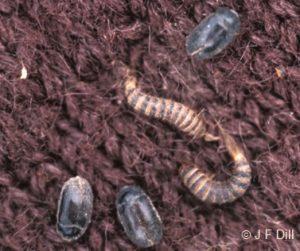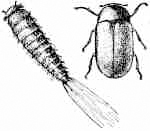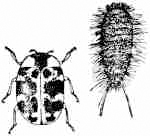Carpet Beetles
Pest Management Fact Sheet #5008
James F. Dill, Pest Management Specialist
Clay A. Kirby (retired), Insect Diagnostician
Charles D. Armstrong, Cranberry Professional & Staff Entomologist
For information about UMaine Extension programs and resources, visit extension.umaine.edu.
Find more of our publications and books at extension.umaine.edu/publications/.
Description & Biology
There are four species of carpet beetles of significance for Maine. Most important, arguably, is the Black carpet beetle, which is black, oval and less than 1/4 inch long. The carrot-shaped larva (young or immature) is less than 1/2 inch long, reddish or golden brown with short hair on its body and a tuft of long hair at the end of its abdomen. Black carpet beetle larvae are more likely to feed on grains than other species of carpet beetle larvae. The other three species of carpet beetles to be aware of are the Varied carpet beetle (Anthrenus verbasci), the Furniture carpet beetle (Anthrenus flavipes), and the Common carpet beetle (Anthrenus scrophulariae), which is also known as the Buffalo carpet beetle or the Marbled carpet beetle.
Since adults of the Varied, Furniture and Common carpet beetles are similar in form and habits, they can be discussed as a group. These beetles are about 1/8-inch long and have a broadly oval appearance. There are minor differences in the 1/4-long larvae of these three pests.
The larval stage does most of the damage. Even though they are called carpet beetles, the larvae feed on many other items. Preferred foods include animal products such as skins, furs, feathers, wool, hair and dead insects, but they also eat cotton to some extent. They are known to eat holes in yarns that are blends of wool and synthetic fibers. Because synthetics are not digestible, larvae need to eat more of each material to get enough wool to meet their nutritional requirements. Consequently, significant feeding damage can occur.
Adult beetles are good fliers and are often attracted to light. Finding adult beetles on window sills is often the first sign of an infestation. By such time, however, the larvae have already inflicted a lot of damage to whatever material was consumed.
Beetle infestation occurs in many ways. In warmer climates, carpet beetles can survive outside, providing a ready source for household infestation. In Maine, these insects are more likely to come into homes on clothes, cloth or almost anything that is brought indoors.
- Carpet Beetle adults and larvae
- Black Carpet Beetle and Larva
- Varied Carpet Beetle and Larva
Management
Carpet beetles are best controlled by a pest management professional. However, there are steps one can take to prevent or control these pests.
Good housekeeping helps prevent infestations and, more importantly, reveals infestations early before significant damage can be done. It is wise to treat, wash or dry clean second-hand clothes immediately upon bringing them home. If exposed to beetles, untreated animal skins, fur clothes, woolen rags, etc., are likely to become infested. Be sure to clean out-of-season items before storing them. Checking items that have not been used for several months helps prevent severe damage. Clothes that were worn or soiled, e.g. socks, sweaters or slippers are more likely to hold sweat or food particles, making the garments more attractive to these pests.
Control
Dry cleaning kills the pests in all stages of development; washing is also helpful, as is using a clothes dryer. Remember that woolens are damaged by temperatures above 100°F; temperatures in clothes dryers range from 160 to 210°F. Placing clothes in tight plastic bags or trunks helps to discourage beetles, but is not always effective. Napthalene mothballs or flakes are a fair preventive. Paradichlorobenzene flakes are better because they also have some insecticidal effect. Do not count on cedar closets or chests to keep moths or carpet beetles from damaging garments. Moth-proof the garments. Valuable furs are best-protected when kept in cold storage (45°F or lower).
Vacuuming upholstered furniture, carpets and carpet pads (especially edges of carpets and near mop boards), and hard-to-reach areas under furniture may also lessen the degree of an infestation. Do not overlook lint in isolated areas like heat ducts and attics.
Beetles can survive on foods caught under sinks and behind refrigerators. Pet foods can also sustain a carpet beetle infestation. Be aware of what is stored in attics. Anything beetles can feed on that was not treated with an insecticide and lies in an undisturbed place attracts the pests. Even felts in pianos and lined instrument cases have been destroyed. Check rodenticide baits (d-Con®, Havoc®, etc.) as such baits do not kill insects that feed on them.
It’s important to remember that there are two kinds of clothes moth larvae that prefer the same foods as carpet beetle larvae. Several other beetles resemble carpet beetles in color and shape, but these primarily attack dried fruits and grains. Items infested with larvae of these insects may be thought to be infested with carpet beetles. Thus, it is very important to identify pests correctly so that the most appropriate control measures are carried out.
Using insecticides to control carpet beetles requires a thorough application in the proper places–wherever infestations might lurk. Insecticides that are registered for carpet beetle control are cyfluthrin, bifenthrin, deltamethrin, permethrin and tetramethrin. Liquid or EC (emulsifiable concentrates), dusts and aerosol (pressurized) sprays are the usual insecticide formulations used.
Carpet Considerations
A word of caution is in order: red dyes, even when used to make other colors, of some carpets may change color or stain when sprayed with some insecticide formulations. Check labels for such warnings! When you need to treat a carpet but do not know the potential for discolorations, first treat only a small, inconspicuous spot on the carpet with the insecticide. Check the test spot for discoloration or staining in a week or so. This color test is done at your own risk. When purchasing a carpet, document the discoloration (dye or staining) potential for future reference.
When Using Pesticides
Always Follow Label Directions!
Pest Management Unit
Cooperative Extension Diagnostic and Research Laboratory
17 Godfrey Drive, Orono, ME 04473
1.800.287.0279 (in Maine)
Information in this publication is provided purely for educational purposes. No responsibility is assumed for any problems associated with the use of products or services mentioned. No endorsement of products or companies is intended, nor is criticism of unnamed products or companies implied.
© 2016 | Reviewed/Revised: 2025
Call 800.287.0274 (in Maine), or 207.581.3188, for information on publications and program offerings from University of Maine Cooperative Extension, or visit extension.umaine.edu.
The University of Maine System (the System) is an equal opportunity institution committed to fostering a nondiscriminatory environment and complying with all applicable nondiscrimination laws. Consistent with State and Federal law, the System does not discriminate on the basis of race, color, religion, sex, sexual orientation, transgender status, gender, gender identity or expression, ethnicity, national origin, citizenship status, familial status, ancestry, age, disability (physical or mental), genetic information, pregnancy, or veteran or military status in any aspect of its education, programs and activities, and employment. The System provides reasonable accommodations to qualified individuals with disabilities upon request. If you believe you have experienced discrimination or harassment, you are encouraged to contact the System Office of Equal Opportunity and Title IX Services at 5713 Chadbourne Hall, Room 412, Orono, ME 04469-5713, by calling 207.581.1226, or via TTY at 711 (Maine Relay System). For more information about Title IX or to file a complaint, please contact the UMS Title IX Coordinator at www.maine.edu/title-ix/.




